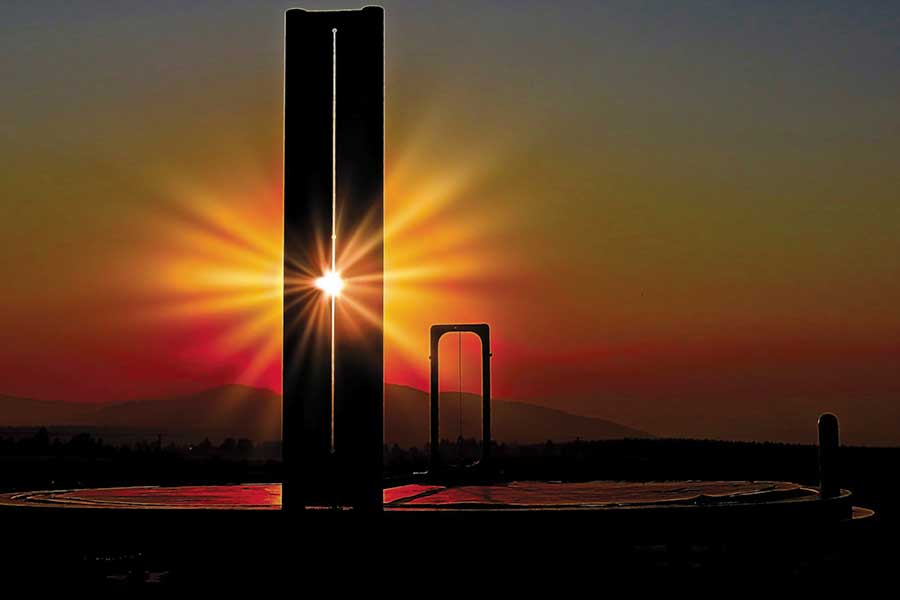By Debbie Burke
What’s more romantic than being atop a mountain, surrounded by millions of trees, in Norman Maclean’s words: “with nothing to do but to watch, seemingly the sky itself bends, and the stars blow down through the trees until the Milky Way becomes lost in some distant forest.”
For more than a century, adventurous souls hiked up remote peaks in Montana and Idaho where they lived in towers and watched for wildfires.
These forest guardians have long been first responders, rushing to extinguish lightning-caused blazes while they were still small. Early lookouts camped in tents on mountaintops, keeping vigil with binoculars.
In 1910, wildfires destroyed towns and killed more than 85 people in western Montana, Idaho, Washington, and British Columbia. That prompted the US Forest Service (USFS) to ramp up protection efforts. Those plans included building lookout towers on mountains.
Historian Mark Hufstetler is a longtime veteran at Baptiste Lookout in the Flathead National Forest. He explains crews constructed the first towers from timber and material found near the sites. Later, building supplies were brought by mule. In the late 1920s, a standardized design called the L-4 was adopted, a wood-frame 14’ by 14’ structure with windows and catwalks all around. From the 1920s to 1950s, hundreds of L-4s were built, using kits of pre-cut, numbered pieces of lumber, similar to Sears-style home kits.
In the 1930s, the Civilian Conservation Corps cleared trails and strung phone lines to the towers. During World War 2, conscientious objectors worked in forestlands and built Heaven’s Peak Lookout in Glacier National Park.
Following World War 2, DC-3 planes delivered building material to sites in the winter, dropping kit packages on snow to cushion the landing. When spring arrived, crews climbed to the site to put the lookouts together. Some were perched on stilts up to 100’ tall.
Interiors featured a cot or two, a stove for heat and cooking, storage, table and chairs, and a critical piece of equipment, the Osborne Firefinder.
In 1911, Forest Service employee William Bushnell Osborne, Jr. invented the “Firefinder.” Using a map mounted on a rotating steel disc with brass sighting mechanisms attached, smoke and fire locations could be accurately pinpointed. It required no electricity nor batteries and was accurate even when positioned on a stump as a platform.
In competent hands, the Firefinder proved as accurate as current GPS or aerial sighting.
Lookouts called in reports on phone lines strung through trees. They spent hours, walking trails to repair breaks caused by weather and wildlife becoming tangled in single strand wires.
Phone and radio communication provided vital daily weather reports because lightning strikes can cause smoldering as long as two weeks before blowing up in a fire.
Despite solitude, the life of a lookout wasn’t necessarily lonely since they often served as the communication center for forest workers on the ground, firefighters, other lookouts, spotting planes, and residents living in remote homesteads.
Yaak resident Edward Kuropat worked at the Sylvanite Ranger Station in the early 1980s and recalls the comfort offered by Shamus, a longtime lookout at Mount Henry and Baldy Mountain. “With experience in wildland fire fighting and the calmness of a musician, [Shamus’s] voice was perfect over the radio. When I wandered in the woods, on many days he was my only contact with the outside world. Check in first thing in the morning, lunch, and when done. ‘I’m here for you, buddy. Be safe.’ With those simple words, I knew Shamus would be there as always. He would have my back until I got home.”
Local ranchers and farmers also appreciated their guardian angel. “We sleep better at night knowing he’s up there.”
Who became lookouts?
Honeymooners were attracted by the romantic location where they could also earn money. In 1958, newlyweds Kay and Keith Rosengren packed into Numa Ridge Lookout, near Bowman Lake in Glacier Park. Kay recalls, “Numa was just magic to wake up to.” Even the outhouse had a “fantastic view.” The Rosengrens returned for many summers to work at Numa and Apgar Lookouts.
Young men seeking adventure frequently applied for lookout positions. They were excited to be away from home for the first time, but often lacked knowledge of healthy eating habits and hygiene. After frequent illnesses, including scurvy, forest service wives compiled a basic cookbook that taught nutrition, cleanliness, and recipes. Originally published in 1938 and updated over several decades, it gave directions how to make sourdough starter and multiple variations of Spam, a mainstay.
Staples were canned goods, flour, sugar, macaroni, dried beans, and split peas. Fresh produce was rare except for abundant huckleberries nearby. Hucks starred in muffins, flapjacks, and innumerable pies. Kay Rosengren credits the cookbook with “the best pie crust recipe ever.”
Without refrigeration, food handling was a challenge. One suggestion from the cookbook: “purchase a half or a whole mutton from sheepherders in the vicinity of your station. To keep, hang up in a tree or some other high point at night, wrapped in canvas, or put in a burlap sack during the day and put between blankets and mattress of bed.”
Another handy hint: use vinegar to wipe mold off ham.
No reports on how many cases of food poisoning occurred in those early days!
Laundry was done by washboard. Water was precious, hauled up the mountain in five-gallon metal cans. Melted snow was another source, after straining out debris. Stream water had to be boiled and treated.
Encounters ranged from terrifying to humorous.
An angry black bear once charged Keith Rosengren who ran up the lookout stairs to safety. Kay said she could hear his heart thumping.
When a hiker was mauled by a grizzly, Kay called for help with the lookout radio and phone. A long delay followed while rescuers hiked to the remote location, a sobering reminder of how dangerous life was in isolated wilderness.
On the lighter side, a personable porcupine befriended Kay and used to accompany her to the outhouse.
Retired forester and longtime volunteer Kjell Petersen woke up many mornings at Snow Peak Lookout in Idaho with a mountain goat standing on the outside catwalk, peering at him through the window.
Visitors often asked, “Don’t you get bored?”
Petersen says each moment on the mountain is filled with sensations like the sound of the wind, the sight of a butterfly or a bird, the fresh smell of pine, or sometimes the sinister whiff of smoke. “Nature is a great educator,” he says, “if you slow down enough to learn.”
One afternoon, Petersen was working in the Snow Peak tower when it was struck three times by lightning. He calls it “a see-God moment.”
Boring? Not likely.
Despite hardships and primitive conditions, many lookouts considered summers spent on top of a mountain as the defining experience of their lives, even earning fond mentions in their obituaries.
In 1933, young Wag Dodge (later a smokejumper and crew leader during the 1949 Mann Gulch Fire) wrote about a lookout’s life. His aged, yellowed, typewritten poem is thumbtacked to the ceiling of Star Peak (formerly Squaw Peak) Lookout in the Cabinet Mountains.
In the age of aerial surveillance and satellites, few lookout towers remain in service, staffed by USFS employees. Many were abandoned, destroyed by fire, weather, and time. Several are preserved as historic landmarks. Others are available for rentals (see sidebar).
Still, romance and adventure endure in the magical life of a mountain lookout surrounded by clouds and stars. MSN-ISI
The nonprofit Northwest Montana Lookout Association (nwmt-ffla.org) graciously provided photos, original sources, and oral histories for this story. Special thanks to Kjell Petersen and Mark Hufstetler.
In Debbie Burke’s sixth novel, Flight to Forever, pandemic restrictions prevent a Vietnam veteran from visiting his wife in memory care, so he breaks her out, gravely injuring a guard during the escape. The couple hides at the remote fire lookout in the Bob Marshall where they spent their honeymoon 50 years before. To prevent tragedy, investigator Tawny Lindholm must find them before the law does because the vet has sworn “No retreat, no surrender.” Flight to Forever was a finalist for the Eric Hoffer Book Award and was reviewed in Dec. 2021/Jan. 2022 issue of MSN.









